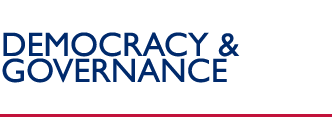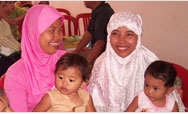Democracy and Governance: USAID/Southern Africa
The Development Challenge: The Regional Center for Southern Africa (RCSA) manages the development assistance component of the Southern Africa regional program. However, USAID South Africa manages the Regional HIV/AIDS Program component of the regional portfolio. The Southern Africa regional program covers the 12 countries that are members of the Southern Africa Development Community (SADC). The SADC member countries range from very poor (Angola, Lesotho, Malawi, Mozambique, Tanzania, and Zambia) to low middle-income (Botswana, Mauritius, Namibia, South Africa, Swaziland, and Zimbabwe). However, even within the wealthier countries in the region, significant income inequality and poverty exist.
Although the region is anchored by the modern and diversified economy of South Africa, many of the countries continue to be predominantly agricultural. Agriculture accounts for an estimated 70% to 80% of employment, but contributes only about 17% to regional gross domestic product (GDP) because of low productivity. Several countries rely heavily on extractive industries, while a few have had some success in increasing non-traditional exports to the United States under the African Growth and Opportunity Act. In most countries in the region, the rate of GDP growth stagnated or fell in 2003; average GDP growth was 4.5% (not including Zimbabwe). This is far below the estimated 6.2% annual growth that the region needs to meet its poverty alleviation goals. Challenged by poverty and insufficient investment, hard hit by the HIV/AIDS pandemic, and continually beset by droughts and food insecurity, the region's population has seen its average life expectancy drop from 57 years to 33 years. The continuing political crisis in Zimbabwe illustrates the fragility of democratic institutions in the region.
Southern Africa remains the region of the world most severely affected by HIV/AIDS. In at least six countries-Botswana, Lesotho, Namibia, South Africa, Swaziland, and Zimbabwe-it is estimated that more than a fifth of the adult population is infected with HIV, and in Botswana and Swaziland (with prevalence rates of 37.3 and 38.8%, respectively) nearly two out of five adults may be HIV-infected. The burden of the epidemic on the region is staggering. With less than 2% of the world's population, the ten Southern African countries account for 30% of HIV-infected individuals, 27% of children orphaned by AIDS, and 32% of AIDS deaths. Moreover, the epidemic has not yet peaked (except, possibly, in Zambia) and the disproportionate effect on the region is likely to continue.
Contrasted with this bleak economic picture is the more positive one of a region with relatively well-developed infrastructure, diverse natural resources, generally better health and education than the rest of Sub-Saharan Africa (apart from HIV/AIDS) and nascent democratic governments. The region remains relatively peaceful compared to other sub-regions of Africa, which makes possible movement towards greater regional integration.
The United States has four main interests in southern Africa: increasing trade and strengthening economic ties with the SADC region; mitigating the region's HIV/AIDS crisis; recurrent food insecurity; and strengthening democracy to improve the climate for trade and reduce the risk of conflict in the region.
(Excerpted from the 2006 Congressional Budget Justification for the Regional Center for Southern Africa)
Back to Top ^
|


